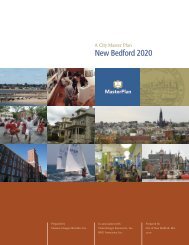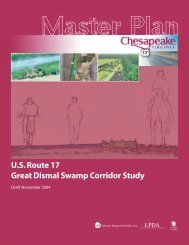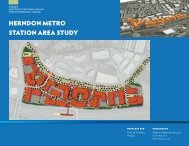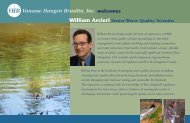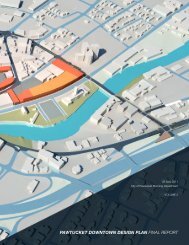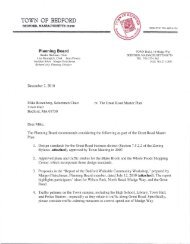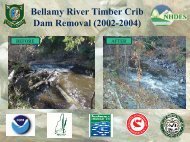Final Report - VHB.com
Final Report - VHB.com
Final Report - VHB.com
Create successful ePaper yourself
Turn your PDF publications into a flip-book with our unique Google optimized e-Paper software.
In terms of standing structures, the area does not contain any buildings or structures<br />
that are more than 45 years old, except for what appears to be a fragment of a wood<br />
bridge railing within the site of the former Merrymeeting Park north of US Route 1.<br />
The area is characterized by more recently constructed <strong>com</strong>mercial developments<br />
and trailer parks. \<br />
5.2.3.2 Strategy 2A - Improved Mobility along State<br />
Route 196 and US Route 201<br />
Transportation Operations<br />
Strategy Area 2A involves roadway improvements to three distinct areas and<br />
evaluates five improvement scenarios, as follows:<br />
I-295 southbound on-ramp (Option 1)<br />
State Route 196/US Route 201 intersection and widening improvements (Options<br />
2, 2A, 3, and 3A)<br />
US Route 201 intersection and roadway improvements at the Topsham Annex<br />
(Options 4 and 5)<br />
Option 1 consists of installing a traffic signal on State Route 196 at the I-295<br />
southbound ramp. The option also involves extending the length of the existing State<br />
Route 196 westbound left-turn lane. The purpose of this option is to safely and<br />
efficiently ac<strong>com</strong>modate motorists turning left onto the I-295 southbound ramp. With<br />
this option in place, operations are projected to improve from LOS E under the No<br />
Action unsignalized condition to LOS A. The option substantially meets each<br />
Feasibility Study objectives except encouraging multimodal mobility.<br />
Option 2 consists of the construction of a two-lane roundabout at the State Route<br />
196/US Route 201 intersection. The concept of the roundabout was developed and<br />
evaluated at this intersection because it was believed – as a suggested at the public<br />
workshop – that it would efficiently process the heavy east-west Coastal Connector<br />
traffic flow while simultaneously introducing a traffic-calming effect that would<br />
reduce travel speeds and, as a result, enhance the safe and efficient movement of<br />
pedestrians and bicyclists. However, results of the operational analyses show the<br />
westbound approach (i.e., motorists entering the roundabout from the Coastal<br />
Connector) operating at LOS F. Additionally, the aggressive TDM program would<br />
reduce the volume of traffic at the roundabout, but the westbound approach would<br />
still operate at LOS F.<br />
Options 3 and 3A consist of grade-separating the Coastal Connector/US Route 201<br />
intersection by having the Coastal Connector bridge over US Route 201. Access to US<br />
Route 201 from the Coastal Connector would be provided by way of connector<br />
Conclusions 150



